Down To Earth(April1-15 2023)
1. INTERGOVERNMENTAL PANEL ON CLIMATE CHANGE (IPCC) IN ITS SYNTHESIS REPORT
- Synthesis Report is a summary of the findings of six reports released during IPCC's Sixth Assessment Cycle in 2018-22. It does not provide any new data but highlights the delay and deception tactics used by industry and governments to cover up inaction.
Findings of the report:
- It reiterates that due to human activities excess emissions have raised the global temperature by 1.1°C above the 1850-1900 level.
- The report states that current levels of Nationally Determined Contributions might not be enough and that warming will exceed 1.5°C during the 21st century, and it will be difficult to stay below a 2°C threshold.
- Increased levels of greenhouse gasses, reduced capacity of carbon sinks will have a compound effect in the form of severe droughts and other natural calamities.
- This will impact human and other forms of life more severely.
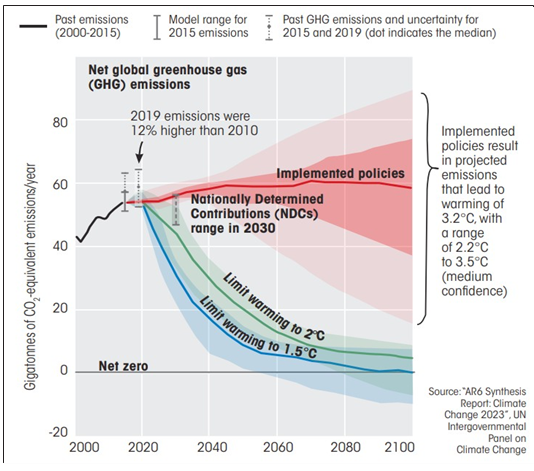
Loopholes in Global Response and Firefighting Measures:
- Overall there has been some progress in adaptation measures but its effectiveness is not much due to certain factors like:
- Some ecosystems have reached their hard limits of adaptation, which means they can not adapt further without causing irreparable damage.
- Some other ecosystems are ready to adapt but are not able to because of unavailability of required technology, funds and other socio-economic factors.
- There is increased evidence of maladaptation in various sectors and regions, which affects marginalized and vulnerable groups adversely.
- Even effective adaptation does not prevent all losses and damages, state the authors of the report.
- There are widening disparities between estimated costs of adaptation and finance allocated to it.
Way forward given by report:
- All the low carbon emitting solutions are available but its implementation should be done on priority basis.
- Solutions include widespread electrification, diversifying energy generation to include renewables, deploying more battery-powered electric vehicles, and conserving and restoring forests while reducing tropical deforestation.
Political commitment and equity are also key to enabling the shift.
- The report emphasizes that accelerated financial support for developing countries from developed countries is a critical enabler, with a greater focus needed on public grant-based finance.
2. EXTREME WEATHER EVENTS AND AGRICULTURE
- UN's IPCC Report, WMO, MoEFCC etc have been repeatedly warning the world of more severe and frequent natural calamities like floods, droughts, cyclones etc. This has also been seen impacting agricultural productivity putting pressure on global food security.
CYCLONE FREDDY
- Cyclone FREDDY which crossed the entire South Indian Ocean and traveled more than 8,000 kilometers to affect six African countries for over two weeks. It broke many records due to intensification as per WMO.
- It had accumulated cyclone energy (ACE) at 87.01 units. ACE is a measure of total wind energy collected by a tropical cyclone.
- Its unique behavior may be due to exposure to warmer waters in the southern Indian Ocean.
Other similar Cyclones:
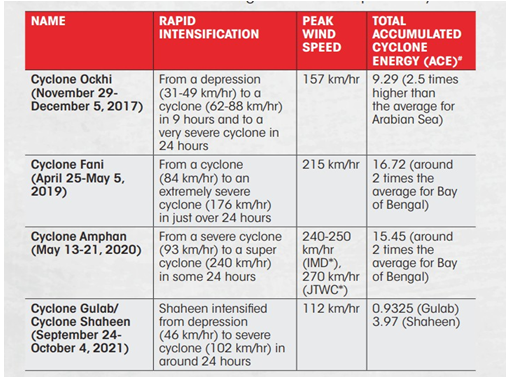
Extreme Events and agriculture:
- An increase in the number of days with extreme temperatures or rain has caused a decline in quality and size of seeds across India.
- Most wheat varieties require a temperature of under 25°C during the day in February-March. A 1°C temperature rise above 25°C shortens the reproductive phase by 6 % and the grain-filling duration by 5 %. March 2022 had several days with temperatures crossing 30°C.
- In 2022, Punjab, Haryana and Uttarakhand witnessed the spread of dwarf virus in paddy linked to high temperature in May and June.
- Drought during the early development of the seeds also reduces their quality at maturity.
- Apart from temperature and rain events, another reason is high speed winds which unsettle the field and uproot the plants.
- Rise in temperature hastens crop development, shortening the seed filling duration. It speeds reproductive development and pollen formation, leading to development of smaller seeds.
Varieties:
- Scientists see disease and climate resilient variety seeds as the possible solution to the problem.
- ICAR has been releasing varieties that can fight heat, disease and extreme weather since 2005.
- In February 2023, IARI registered a new heatwave-resistant wheat variety, HD3385, which is being tested at multiple locations in the current rabi season.
Conclusion:
- The global ocean heat content is at its maximum level as 90% of warmth generated by anthropogenic emissions is absorbed by oceans.
- The UN Intergovernmental Panel on Climate Change's Synthesis Report says that the rate of rise in agricultural productivity has declined over the past 50 years in mid- and low-latitude regions.
- Since this region includes vast parts of India, the country must ensure that its agricultural productivity, which depends on seeds.
3. POLLUTED GANGA
- Minister of State for Jal Shakti told Parliament that the Namami Gange Programme has been able to reduce pollution load in the Ganga river. Since 2014, the Centre had taken up 409 projects with a budget outlay of Rs. 32,912.40 crore to clean up the river.
GANGA
- The Ganges (Ganga) River is a sacred river that begins high in the Himalaya Mountains and empties out into the Bay of Bengal.
- Flowing a vast length of 2,525 Kms, it crosses five states of India namely Uttarakhand, Uttar Pradesh, Bihar, Jharkhand and West Bengal.
- It has a catchment area of 8,61,404 sq. km (26.4%) of India.
- Major tributaries of River Ganga are, Ramganga, Gomti, Ghaghara, Gandak, Damodar, Kosi and Kali-East.

Current Situation of Ganga:
- At least 71 per cent of the river's monitoring stations reported alarming levels of fecal coliform. Fecal coliforms are a group of bacteria found in the gut and feces of warm-blooded animals. It enters into the rivers through discharge of untreated sewage.
- In Uttarakhand had permissible levels of fecal coliform at all 12 tested stations, numbers in three other states i.e Uttar Pradesh, Bihar and West Bengal are alarming.
- In the Ganga basin approximately 12,000 million liters per day (mld) sewage is generated, for which presently there is a treatment capacity of only around 4,000 mld.
- The industrial pockets in the catchments of Ramganga and Kali rivers and in Kanpur city are significant sources of industrial pollution. The major contributors are tanneries in Kanpur, distilleries, paper mills and sugar mills in the Kosi, Ramganga and Kali river catchments.
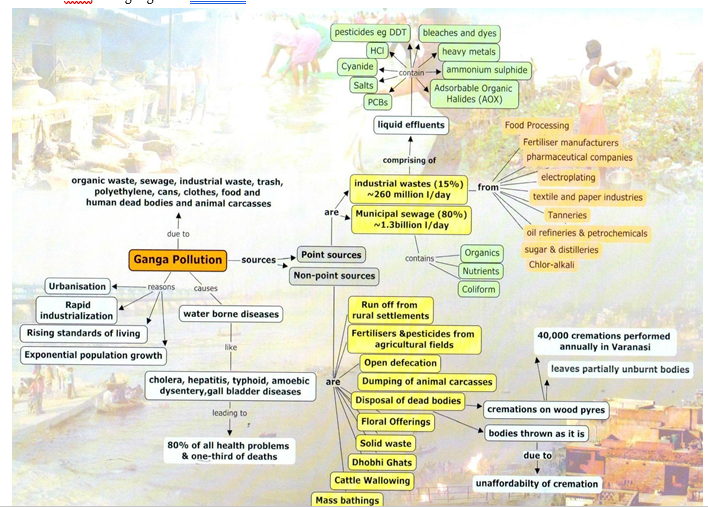
How is monitoring done?
- CPCB currently carries out manual monitoring for five parameters, including faecal coliform.

Challenges in Cleaning Ganga and way forward:
- Data collection and dissemination is a major challenge for cleaning drives. Eg: Sampling is done every 15 days but data is made public monthly thus causing delays in action.
- Under the National Mission for Clean Ganga, manual monitoring should be carried out at 134 stations, but monitoring is currently carried out at 97 stations.
- The Centre released two guidelines in 2007 and 2017 which recommended 25 parameters for perineal rivers and it must be followed.
4. EARTH'S CORE AND GEODYNAMIC
- Earth's core plays a vital role in sustaining life on the planet. Still there is very little knowledge about what lies inside earth.
Structure of Earth:
- The earth is made up of three different layers: the crust, the mantle and the core.
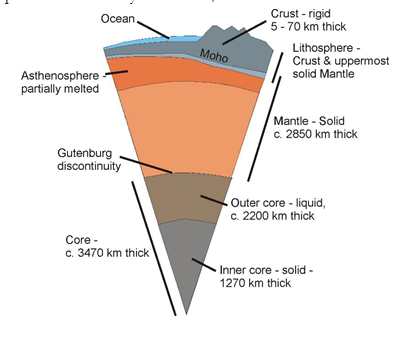
The crust:
- This is the outermost layer of the earth and is made of solid rock, mostly basalt and granite.
- There are two types of crust; oceanic and continental. Oceanic crust is denser and thinner and mainly com posed of basalt. Continental crust is less dense, thicker, and mainly composed of granite.
The mantle:
- The mantle lies below the crust and is up to 2900 km thick.
- It consists of hot, dense, iron and magnesium-rich solid rock.
The core:
- The core is the center of the earth and is made up of two parts: the liquid outer core and solid inner core.
- The outer core is made of nickel, iron and molten rock. Temperatures here can reach up to 50,000 C.
More about The Core:
- Unlike the mineral-rich crust and mantle, the core is made almost entirely of metal, specifically, iron and nickel.
- The liquid outer core separates the inner core from the rest of Earth, and as a result, the inner core rotates a little differently than the rest of the planet.
- Another study confirms the existence of another layer within the inner core, called the innermost inner core.
- It rotates eastward, like the surface, but it's a little faster, making an extra rotation about every 1,000 years.
- Earth's magnetic field is created in the swirling outer core. Magnetism in the outer core is about 50 times stronger than it is on the surface.
- The inner core switches from sub rotation to super rotation every seven decades, which influences the magnetic field.
- Sub Rotation: The inner core rotation slowed in the mid 2000s and then decelerated further; this is called sub-rotation.
- Super Rotation: Inner core super-rotation is the eastward rotation of the inner core of Earth relative to its mantle, for a net rotation rate that is usually faster than Earth as a whole.
Study of Core:
- Very little is known about the earth's interior, especially the core.
- Eg: US space agency NASA's Voyager 1 spacecraft has traveled 23 billion km from the Earth. In contrast, the deepest hole drilled into the planet's surface is just 12.2 km.
- Information about the core has come from sophisticated reading of seismic data, analysis of meteorites, lab experiments with temperature and pressure, and computer modeling.
- Various efforts to study Earth:
- The world's first drilling expedition was the US' Project Mohole, conducted in the early 1960s.
- The 12.2 km deep Kola Superdeep Borehole in Russia is the deepest human made hole on the planet to study layers of earth.
- In 2016 the Union Ministry of Earth Sciences started a unique experiment to drill 3 km into the surface in the Koyna region in MP to study seismic activity in the region.
- Drilling happens on land and on the seafloor, as samples from the latter are believed to be less disturbed.
- International Continental Scientific Drilling Program
- The International Continental Scientific Drilling Program (ICDP), established in 1996, is a consortium of 22 nations, including India, that support land drilling.
- It is headquartered at Potsdam, Germany.
- It has provided funds and research support to the Koyna project.
- International Ocean Discovery Program
- The International Ocean Discovery Program (IODP) is a consortium for ocean drilling, established in 2003 (it was then known as the Integrated Ocean Drilling Program).
- It has 21 participating nations including India.
- It's Science Plan identifies 14 challenge questions in the four areas of climate change, deep life, planetary dynamics, and geohazards.
Importance of Core:
- The core's heat also powers plate tectonics in the crust and the mantle, whose movements create and reshape landscapes, mountains and volcanoes.
- Volcanic eruptions release carbon dioxide, regulating atmospheric greenhouse gas concentrations and surface temperatures.
- These gages return to core through the subduction zone thus forming a cycle. This cycle is thought to have given rise to conditions of life on Earth.
- Earth's magnetic field also acts as protective covering from cosmic radiation and from the charged particles emitted by our Sun. It also provides the basis for navigation with a compass.
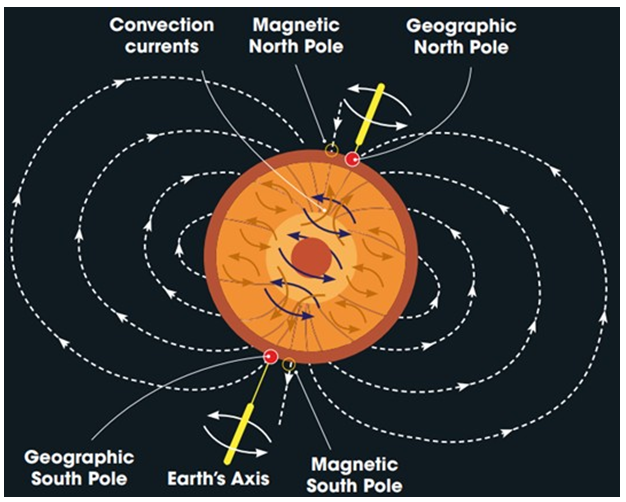
- There are observations that the magnetic field of Earth has lost around 9 % of its magnetic strength showing signs of a magnetic reversal event, where the magnetic north and south poles switch places. This can affect human and animal lives, disrupt satellites and other mechanisms. The last reversal was 772,000-774,000 years ago.
- Scientists also point to the possibility of the magnetic field disappearing due to the shutdown of Earth's dynamo, which may happen once the core completely solidifies. Similar phenomenon happened with Mars.
Future Expedition Plans:
- Countries have been conducting drilling expeditions for decades to learn about earthquakes, volcanic eruptions, microbial life, past climate, the planet's evolution and other processes.
- There is a proposal for the next drilling expedition in the Andaman Islands which could make it possible to reach the Moho in the near future.
- There is a need for more fund allocation and synergy between scientific communities to carry out meaningful research.
5. AI IN PHARMA SECTOR
- Artificial Intelligence has the potential to cut the drug development cycle by half. Yet there are doubts and reliability factors regarding AI tools in drug development.
CASE STUDY
- In 2022, Hong Kong-based pharma company Insilico Medicine along with researchers from Stanford University, US, and the University of Toronto, Canada, began an experiment, powered by three artificial intelligence (AI)tools. The experiment was to find a cure for Hepatocellular carcinoma, the most common form of liver cancer.
- The company's biocomputational platform called PandaOmics scanned through endless research papers online to shortlist 20 potential targets.
- In the second stage, the researchers turned to AlphaFold, a Google owned open access AI system. It predicts a protein's three-dimensional (3D) structure.
- Finally, the researchers fed the 3D structure into Chemistry42, an AI algorithm owned by Insilco Medicine, which designed 8,918 new chemicals.
- The entire process took just 30 days which otherwise would have taken at least six months to a year.
AI benefits in Drug development:
- Developing a new drug costs about US $2.6 billion and an average of 12 years which could be reduced significantly using AI predictions.
- AI companies complete the drug discovery process and preclinical stages in less than four years, while big pharma takes five to six years to reach that stage.
- A branch of AI called machine learning (ML) is widely used in drug discovery where researchers use data sets to train the system and later use it to make predictions in new data sets.
- AI models can analyze vast quantities of data from different sources far beyond the capacity of humans.
Limitations AI in Pharma:
- Most potential drugs fail clinical trials because the wrong target was chosen which remains a challenge since human understanding is limited about it. An AI cannot do much if our understanding of the disease is incomplete or poor.
- Eg: Billions of dollars have been spent to develop drugs for Alzheimer's that target beta-amyloid but the process is not yet successful.
- AI does not develop an understanding of the subject, creating a “black box”. Meaning It does not reveal the logic behind its prediction or decision, leading to misinterpretation and bias.
- There is a high degree of trust issues regarding AI created drugs among biologists and industry leaders.
Conclusion:
- AI is far from perfect but technology will get better over time as it learns since it learns from data fed into it from each cycle of optimizing the design, synthesizing the chemical and testing it.
- Technology will be more widely used in the future but cannot take over human discovery of drugs.
- As of now, there are no AI designed and developed drugs in the market.
QUICK LINKS